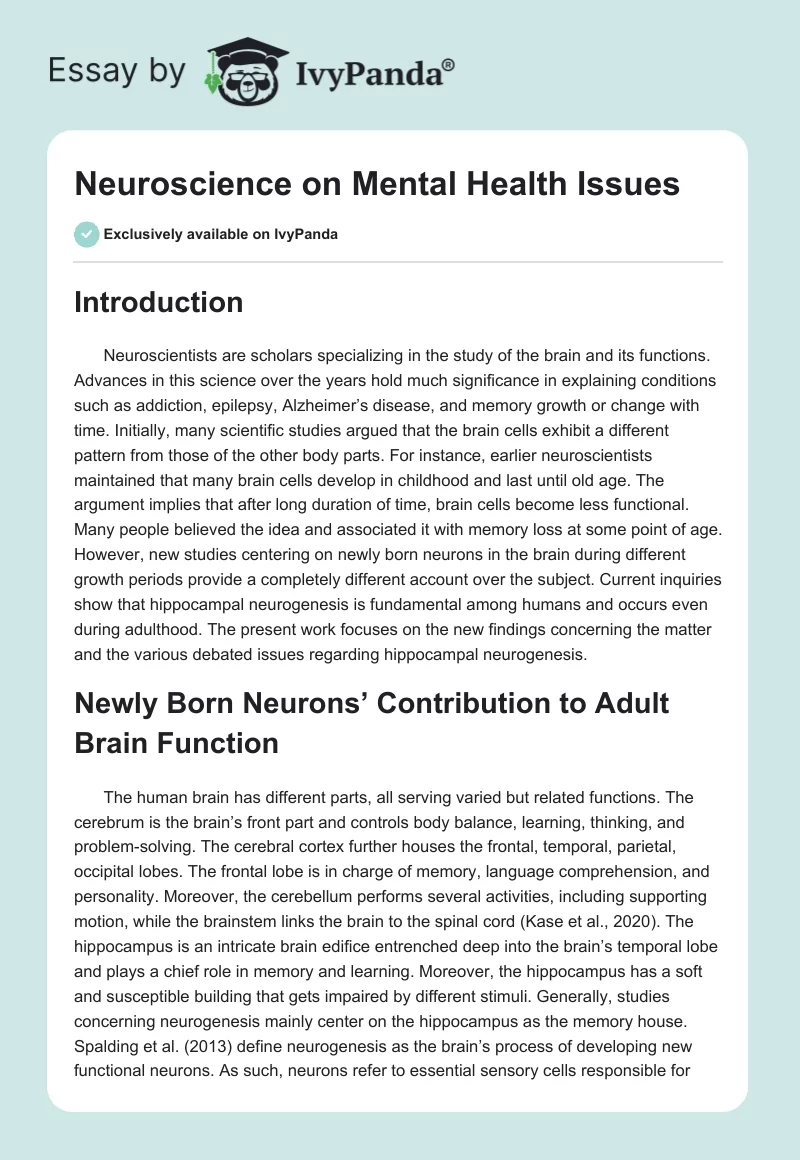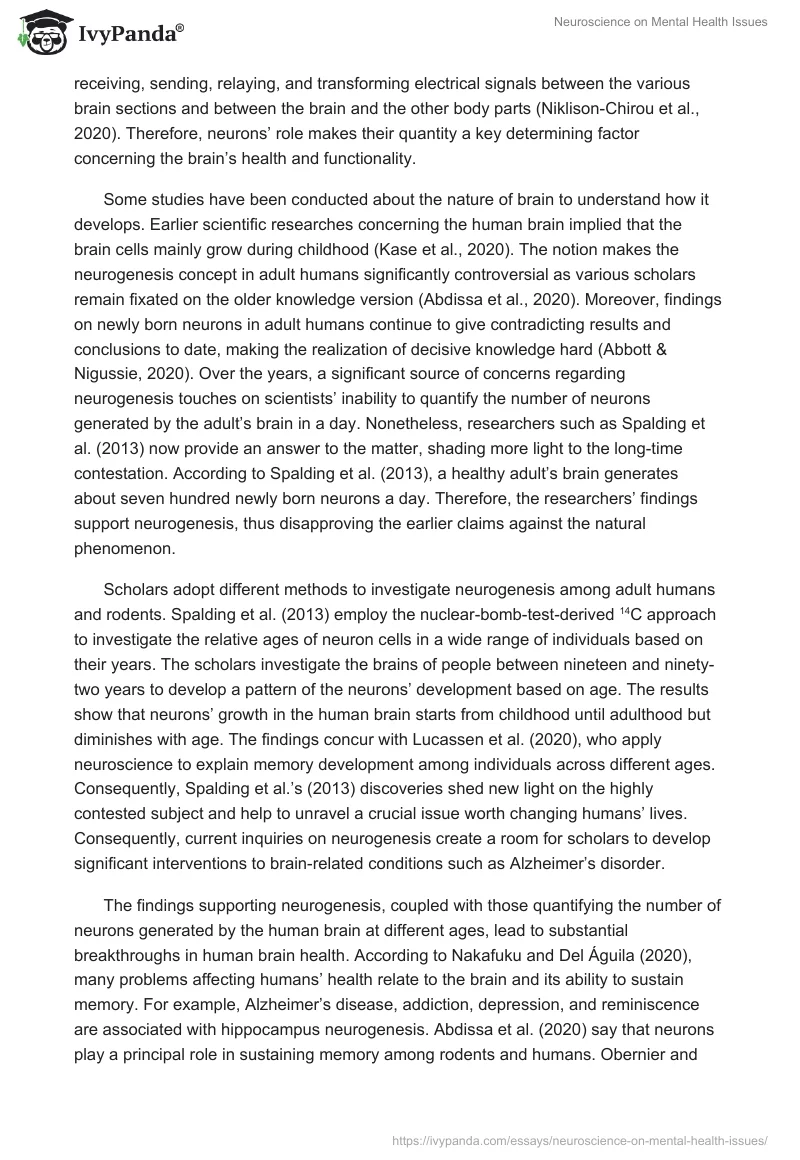Introduction
Neuroscientists are scholars specializing in the study of the brain and its functions. Advances in this science over the years hold much significance in explaining conditions such as addiction, epilepsy, Alzheimer’s disease, and memory growth or change with time. Initially, many scientific studies argued that the brain cells exhibit a different pattern from those of the other body parts. For instance, earlier neuroscientists maintained that many brain cells develop in childhood and last until old age. The argument implies that after long duration of time, brain cells become less functional. Many people believed the idea and associated it with memory loss at some point of age. However, new studies centering on newly born neurons in the brain during different growth periods provide a completely different account over the subject. Current inquiries show that hippocampal neurogenesis is fundamental among humans and occurs even during adulthood. The present work focuses on the new findings concerning the matter and the various debated issues regarding hippocampal neurogenesis.
Newly Born Neurons’ Contribution to Adult Brain Function
The human brain has different parts, all serving varied but related functions. The cerebrum is the brain’s front part and controls body balance, learning, thinking, and problem-solving. The cerebral cortex further houses the frontal, temporal, parietal, occipital lobes. The frontal lobe is in charge of memory, language comprehension, and personality. Moreover, the cerebellum performs several activities, including supporting motion, while the brainstem links the brain to the spinal cord (Kase et al., 2020). The hippocampus is an intricate brain edifice entrenched deep into the brain’s temporal lobe and plays a chief role in memory and learning. Moreover, the hippocampus has a soft and susceptible building that gets impaired by different stimuli. Generally, studies concerning neurogenesis mainly center on the hippocampus as the memory house. Spalding et al. (2013) define neurogenesis as the brain’s process of developing new functional neurons. As such, neurons refer to essential sensory cells responsible for receiving, sending, relaying, and transforming electrical signals between the various brain sections and between the brain and the other body parts (Niklison-Chirou et al., 2020). Therefore, neurons’ role makes their quantity a key determining factor concerning the brain’s health and functionality.
Some studies have been conducted about the nature of brain to understand how it develops. Earlier scientific researches concerning the human brain implied that the brain cells mainly grow during childhood (Kase et al., 2020). The notion makes the neurogenesis concept in adult humans significantly controversial as various scholars remain fixated on the older knowledge version (Abdissa et al., 2020). Moreover, findings on newly born neurons in adult humans continue to give contradicting results and conclusions to date, making the realization of decisive knowledge hard (Abbott & Nigussie, 2020). Over the years, a significant source of concerns regarding neurogenesis touches on scientists’ inability to quantify the number of neurons generated by the adult’s brain in a day. Nonetheless, researchers such as Spalding et al. (2013) now provide an answer to the matter, shading more light to the long-time contestation. According to Spalding et al. (2013), a healthy adult’s brain generates about seven hundred newly born neurons a day. Therefore, the researchers’ findings support neurogenesis, thus disapproving the earlier claims against the natural phenomenon.
Scholars adopt different methods to investigate neurogenesis among adult humans and rodents. Spalding et al. (2013) employ the nuclear-bomb-test-derived 14C approach to investigate the relative ages of neuron cells in a wide range of individuals based on their years. The scholars investigate the brains of people between nineteen and ninety-two years to develop a pattern of the neurons’ development based on age. The results show that neurons’ growth in the human brain starts from childhood until adulthood but diminishes with age. The findings concur with Lucassen et al. (2020), who apply neuroscience to explain memory development among individuals across different ages. Consequently, Spalding et al.’s (2013) discoveries shed new light on the highly contested subject and help to unravel a crucial issue worth changing humans’ lives. Consequently, current inquiries on neurogenesis create a room for scholars to develop significant interventions to brain-related conditions such as Alzheimer’s disorder.
The findings supporting neurogenesis, coupled with those quantifying the number of neurons generated by the human brain at different ages, lead to substantial breakthroughs in human brain health. According to Nakafuku and Del Águila (2020), many problems affecting humans’ health relate to the brain and its ability to sustain memory. For example, Alzheimer’s disease, addiction, depression, and reminiscence are associated with hippocampus neurogenesis. Abdissa et al. (2020) say that neurons play a principal role in sustaining memory among rodents and humans. Obernier and Alvarez-Buylla (2019) maintain that the human brain develops new folds of hippocampal neurons when an individual is between two to five years old. The results support Brown et al.’s (2021) argument that young people, similar to young rodents, sustain memories in a short span as massive new neurons develop in the brain. Apple et al.’s (2017) study suggests that newly born neurons’ development during childhood leads to the erasing of old memories, as the new memory cells replace them. The discoveries imply that fresh neurons influence brain activities depending on their volume, which changes with age.
Research advances in hippocampal neurogenesis also correlate with the revolution in Alzheimer’s disease management. According to Sung et al. (2020), Alzheimer’s disease affects about six million Americans. The condition exhibits severe memory loss and lack of control. The health-related mental problem primarily affects aging persons from fifty-five years in the U.S and other parts of the world. (Babcock et al., 2021). Different scholars associate Alzheimer’s disorder to the decrease in neurons’ activity in the human brain. Other scientific examinations also attach the piling of specific inhibitory protein molecules between brain chambers to the memory loss problem among the aged (Ghosh, 2019). However, investigations on neurogenesis in the hippocampus section of the brain show a different approach to the matter. Zhao and van Praag (2020) maintain that memory retention in humans and rodents mainly depends on the number of newly born neurons available in the brain. Accordingly, young individuals rapidly lose older memory as the newly developed neurons replace the older ones, as per Xie et al. (2020). Adults have refined memory because the volume of older neurons exceeds newly born neurons developed by the brain.
Nonetheless, the healthy balance between old and new neurons in healthy adults promotes memory and learning. That is why the brain functions effectively at a given age period during a human’s life, according to Bao and Song (2018). Spalding et al. (2013) propose an optimum generation of seven hundred newly born neurons a day by the adult brain for effective memory retention and normal function. The study’s outcomes further depict a significant decline in the fresh neurons’ population with aging. Christian et al. (2020) say that neurogenesis activities in humans reduce significantly after fifty-five years, implying newly born neurons-deficiency related memory loss, which is connectable to Alzheimer’s disease. Ferreira et al. (2018) purport that finding ways to promote neurogenesis past fifty-five years can help resolve or delay the age-related memory loss problem. Attaining such a breakthrough further indicates a solution to a health condition troubling most individuals.
Hippocampal neurogenesis further provides answers to epilepsy, depression, and addiction issues. Epilepsy is a mental health problem characterized by seizures and memory loss (Danzer, 2019). Danzer’s (2019) study shows that epileptic adult’s exhibit reduced newly born neurons in comparison with healthy brain. The discovery implies the centrality of hippocampal neurogenesis in promoting brain health. Nonetheless, Danzer (2019) fails to determine ways to increase the number of new neurons among patients to solve the problem. Additionally, Brown et al. (2021) purport that addiction and depression conditions relate to newly born neurons in the human and rodents’ brains. The scholars show that many young people and rodents whose brains produce novel neurons rapidly manage to withdraw quickly from addictions and depression, compared to adults with lower neurogenesis rates. The outcomes relate to Lucassen et al. (2020) concerning old memory deletion among young people due to the rapid production of newly born neurons, which reduces with age. All these accounts prove the essence of neuroscience and the need to advance studies towards finding solutions to issues affecting humanity.
Conclusion
In conclusion, this work shows the essence of neuroscience in investigating and finding solutions to mental issues affecting humanity. Advances in the neuroscience segment challenge the past mentality that brain cells, including neurons, develop mainly during childhood. The earlier account posits that brain cells degrade with age until a point when they reach severe dilapidation, causing conditions such as Alzheimer’s disease. Neurogenesis now holds the key to unraveling many problems affecting people. For example, studies on the subject presently better explain epilepsy, depression, and addiction. Further investigations on the possible ways to promote newly born neurons among humans are crucial to treating many mental problems affecting humans.
References
Abbott, L. C., & Nigussie, F. (2020). Adult neurogenesis in the mammalian dentate gyrus.Anatomia, Histologia, Embryologia, 49(1), 3-16. Web.
Abdissa, D., Hamba, N., & Gerbi, A. (2020). Review article on adult neurogenesis in humans.Translational Research in Anatomy, 20, 100074. Web.
Apple, D. M., Fonseca, R. S., & Kokovay, E. (2017). The role of adult neurogenesis in psychiatric and cognitive disorders.Brain Research, 1655, 270-276. Web.
Babcock, K. R., Page, J. S., Fallon, J. R., & Webb, A. E. (2021). Adult hippocampal neurogenesis in aging and Alzheimer’s disease.Stem Cell Reports, 16(4), 681-693. Web.
Bao, H., & Song, J. (2018). Treating brain disorders by targeting adult neural stem cells.Trends in Molecular Medicine, 24(12), 991-1006. Web.
Brown, S. J., Boussaad, I., Jarazo, J., Fitzgerald, J. C., Antony, P., Keatinge, M., & Bandmann, O. (2021). PINK1 deficiency impairs adult neurogenesis of dopaminergic neurons.Scientific Reports, 11(1), 1-14. Web.
Christian, K. M., Ming, G. L., & Song, H. (2020). Adult neurogenesis and the dentate gyrus: Predicting function from form.Behavioral Brain Research, 379, 112-346. Web.
Danzer, S. C. (2019). Adult neurogenesis in the development of epilepsy.Epilepsy Currents, 19(5), 316-320. Web.
Ferreira, A. C., Santos, T., Sampaio-Marques, B., Novais, A., Mesquita, S. D., Ludovico, P., & Marques, F. (2018). Lipocalin-2 regulates adult neurogenesis and contextual discriminative behaviors.Molecular Psychiatry, 23(4), 1031-1039. Web.
Ghosh, H. S. (2019). Adult neurogenesis and the promise of adult neural stem cells.Journal of Experimental Neuroscience, 13, 1179069519856876. Web.
Kase, Y., Shimazaki, T., & Okano, H. (2020). Current understanding of adult neurogenesis in the mammalian brain: how does adult neurogenesis decrease with age?Inflammation and Regeneration, 40(1), 1-6. Web.
Lucassen, P. J., Fitzsimons, C. P., Salta, E., & Maletic-Savatic, M. (2020). Adult neurogenesis, human after all (again): Classic, optimized, and future approaches.Behavioral Brain Research, 381, 112458. Web.
Nakafuku, M., & Del Águila, Á. (2020). Developmental dynamics of neurogenesis and gliogenesis in the postnatal mammalian brain in health and disease: Historical and future perspectives.Wiley Interdisciplinary Reviews: Developmental Biology, 9(3), e369. Web.
Niklison-Chirou, M. V., Agostini, M., Amelio, I., & Melino, G. (2020). Regulation of adult neurogenesis in mammalian brain.International Journal of Molecular Sciences, 21(14), 4869. Web.
Obernier, K., & Alvarez-Buylla, A. (2019). Neural stem cells: origin, heterogeneity and regulation in the adult mammalian brain.Development, 146(4), 156059. Web.
Spalding, K. L., Bergmann, O., Alkass, K., Bernard, S., Salehpour, M., Huttner, H. B. & Frisén, J. (2013). Dynamics of hippocampal neurogenesis in adult humans. Cell, 153(6), 1219–1227. Web.
Sung, P. S., Lin, P. Y., Liu, C. H., Su, H. C., & Tsai, K. J. (2020). Neuroinflammation and neurogenesis in Alzheimer’s disease and potential therapeutic approaches.International Journal of Molecular Sciences, 21(3), 701. Web.
Xie, F., Liu, H., & Liu, Y. (2020). Adult neurogenesis following ischemic stroke and implications for cell-based therapeutic approaches.World Neurosurgery, 138, 474-480. Web.
Zhao, X., & van Praag, H. (2020). Steps towards standardized quantification of adult neurogenesis.Nature Communications, 11(1), 1-10. Web.


